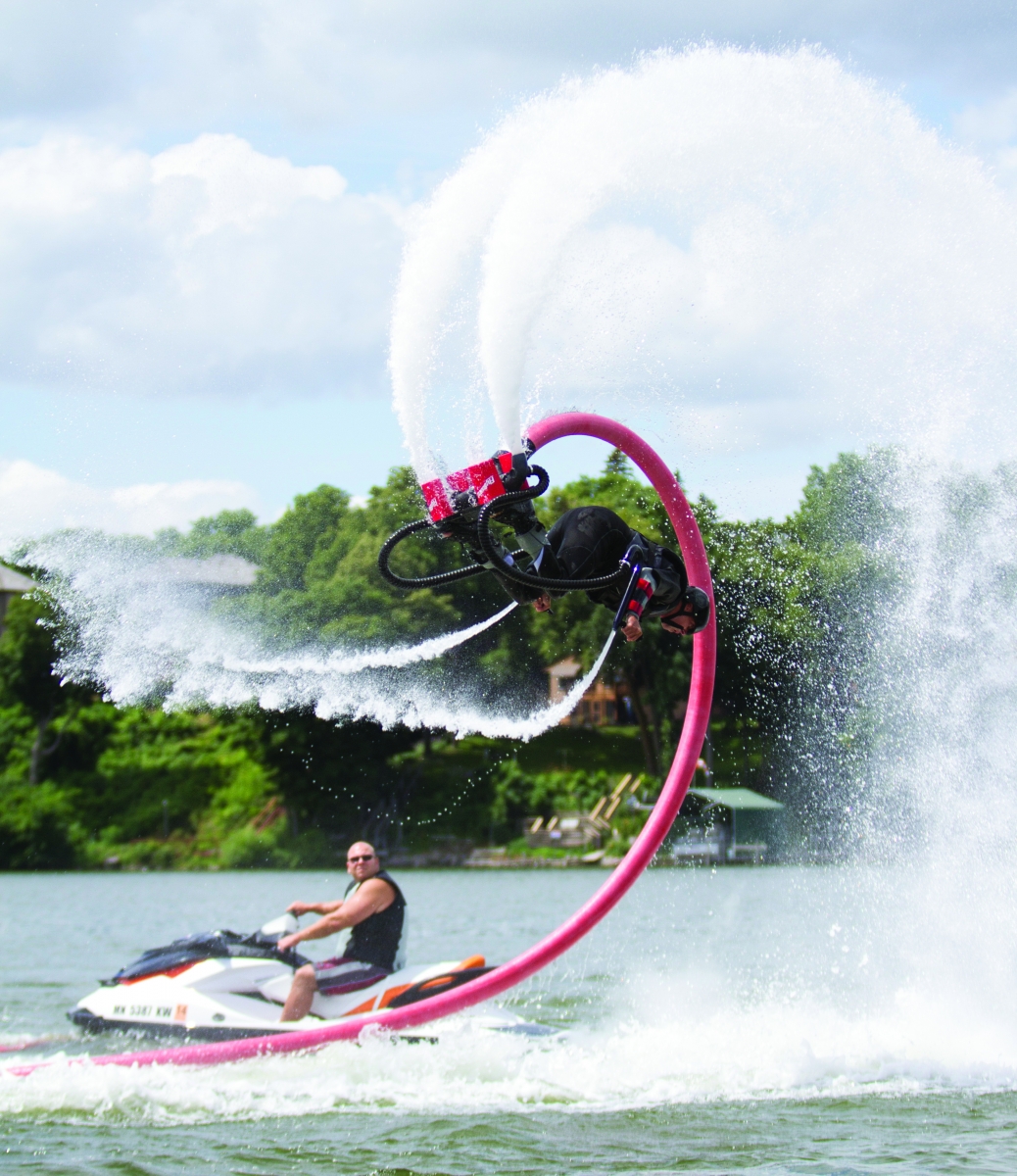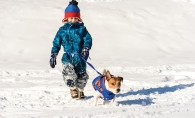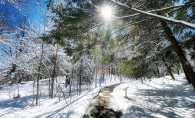Each summer, Lake Minnetonka overflows with speedboats, pontoons and people: The pull of the water can’t be denied. But for those of us who need a little more activity than sunbathing provides, two lake-area businesses offer extreme water sports that the likes of a non-coastal town rarely sees. Read on to find out more about flying high above the waves this season.
If you saw something straight out of the movie Iron Man on Lake Minnetonka last summer, your eyes weren’t deceiving you. A comic book character didn’t leap off the screen, but what some consider the future of water sports zoomed into the lake region with pizzazz that’s straight out of a Hollywood blockbuster.
“It looked scary, and I was a little nervous when I took off, but it was so much fun,” says Wayzata resident Nikki Vanecek, who discovered flyboards on Facebook.

A French Jet-Ski champion and entrepreneur invented the flyboard in 2011. Popularity spread over the Internet and the company rapidly expanded to lake and ocean communities. People can “fly” at heights of 30 feet in the air and also sail through water, both using thrust from a Jet-Ski. Besides feeling weightless, riders also have a unique perspective. “You just get up there and enjoy the ride,” Vanecek says.
You almost have to watch a flyboard in action to understand it. Without the hoses, a flyboard looks like boots attached to a snowboard. A hose extends from the base of the board and attaches to a personal watercraft. The thrust from the Jet Ski propels the rider out of the water in whatever direction the rider chooses.
The rider tilts her feet to control movement and a hose attaches to each of the rider’s arms so she can balance, much as you would with ski poles. “It’s an interesting sensation,” Vanecek says. “You sit in the water like you are sitting on a chair. Once the Jet-Ski driver hits the gas or throttle, you have a gentle pull out of the water and you are hovering over the water.”
The man driving the Jet-Ski—and the flyboard rentals—on Lake Minnetonka is Rodney Jansen. He heard about flyboards through a friend and saw them in action online. After a company representative visited Jansen and let him experience the ride, he was sold. “I thought it was the most fun I’ve ever had,” Jansen says. “I thought, ‘I’m getting one of these no matter what.’”
Since Jansen had experience renting Jet Skis on Lake Minnetonka, introducing flyboards seemed like a good idea. “I grew up [here] and it’s a very popular lake,” says Jansen, “so I know [the sport is] just going to explode. Everyone who sees it says, ‘I want to do it.’ ” Jansen says most of the public hasn’t heard of flyboards, so he’s used to stares when he’s used them around the lake. “People see it and just start talking about it,” he says. “There’s nothing like this that’s been invented.”
Minnesota Flyboard Rentals, Jansen’s company, currently has two flyboard units that he rents for $299 an hour. He offers a series of packages ranging from a half-hour rental to a full day. With those packages, Jansen provides instruction and drives the Jet-Ski.
Jansen says flyboards are very safe. “In a rental, I’d be on the Jet-Ski running the throttle. I’m going to get them a foot out of the water, let them get their balance and slowly raise them up,” Jansen says. “They are fully in control of everything they do except they aren’t running the throttle. If they get too close to the Jet-Ski, I can shut them down.” Flyboard riders must be at least 18 years old to ride and must wear a personal floatation device.
Jansen also rents out the flyboard for lake parties, which is what Vanecek plans to do for her son’s 21st birthday. “He doesn’t even know it yet,” she says. “It’s just a super-fun ride.” Vanecek says it takes about a half-hour to get the hang of the ride, and then you are soaring.
Flyboards seemed like just the kind of thing that Ryan Dobey of Waverly wanted to try. Like most first-time riders, Dobey saw flyboards online. Though people said he was crazy to try it and he’d get hurt, Dobey says, “by far, it’s one of the lower-key sports.” Dobey says the zero gravity aspect reminded him of riding the Power Tower at Valleyfair, but without a seat. “You shoot straight into the air,” he says. “And don’t let it trick you. It’s not as scary as it looks.”
Brandon Tolliver’s story starts 10 years ago, when he and his college friends watched several YouTube videos that inspired them to try surfing a boat’s wake on Lake Minnetonka.
While that may sound like a recipe for disaster, it has led to anything but. Today, Tolliver is a professional athlete, co-owner of Surf Tonka, and—as I experienced first-hand—a fantastic teacher.

Tolliver, a Minnetonka resident and Hopkins High School graduate, grew up boating on Lake Minnetonka. When he saw those YouTube clips of wakesurfing (which is exactly what it sounds like—surfing on a boat’s wake), he had to give it a try. “It was a learning curve. It probably took me a month [to drop the tow rope],” says Tolliver, noting that he learned almost everything about the sport through trial and error.
A very different experience awaited me when I showed up for my wakesurfing lesson. After getting some instruction from Tolliver on the board (I used a short, skim-style board, which means the board has one fin), the boat, (Surf Tonka uses a special wakesurfing boat made by TIGE and built in Texas that can gain 3,000 pounds of water weight on one side) and surfing itself, it was time for me to get in the water. As a transplant to the area, I don’t have as much experience with water sports as most native Minnesotans, so I was pretty nervous that I wouldn’t be a natural surfer. Tolliver, however, didn’t share any of my concerns. He was genuinely excited for me to experience the sport and very confident that he could coach me to success.
My first few attempts were rough, but Tolliver was very encouraging and gave me detailed feedback (“Push down harder on the board, especially with your right foot,” “Pull harder against the tow rope”). I stayed on the board a little longer every time. One of the best parts of my many failed attempts was realizing that unlike water skiing, it doesn’t hurt to fall while wakesurfing. Because wakesurfing requires about half the speed of wakeboarding or water skiing, there’s less of an impact when the surfer hits the water. While my arms and abs got a decent workout with each new attempt, my body wasn’t sore or bruised.
After about 15 minutes, I got up on the board. Just like riding a bike, once I got up, I was able to do it again and again. (“This is so easy,” I shouted to Tolliver at one point. How quickly I had forgotten the two dozen earlier attempts!). Although I struggled to keep my right foot back and I never let go of the tow rope, I was thrilled that I had surfed Lake Minnetonka.
Then it was Tolliver’s turn to hop in the water. Since 2011, Tolliver has competed in world wakesurfing competitions, including the 10,000 Lakes Wakesurf Open in Long Lake in August 2013. Wakesurfers compete in two divisions, skim or surf, depending on the board style. Judges score surfers on their consistency, control, and variety and difficulty of tricks. Tolliver showed me several of his tricks, proving that there is a reason that he has consistently found himself near the top of the leader board in both skim and surf divisions.
Watching Tolliver ride the waves, I could see why wakesurfing is the fastest-growing water sport in the nation. Not only is it a lot of fun and quite a bit easier than I thought it would be, but it is far less restrictive than traditional water sports. “This sport has taken over the industry,” says Tolliver. “It brings everyone together. From 8-year-old kids to 60-year-olds, anyone can do it.”
For more information, visit rentflyboards.com.
For more information about private or group lessons, visit surftonka.com.









